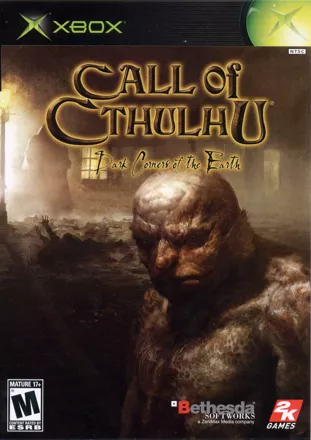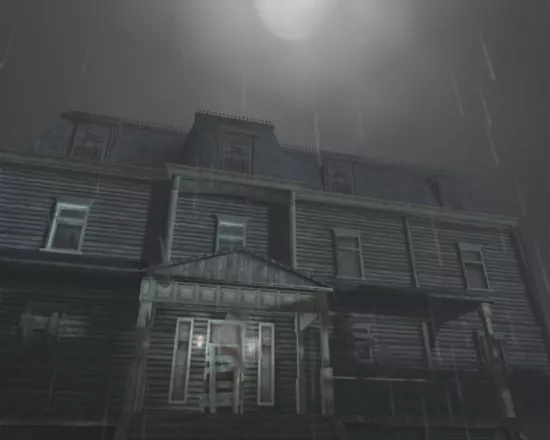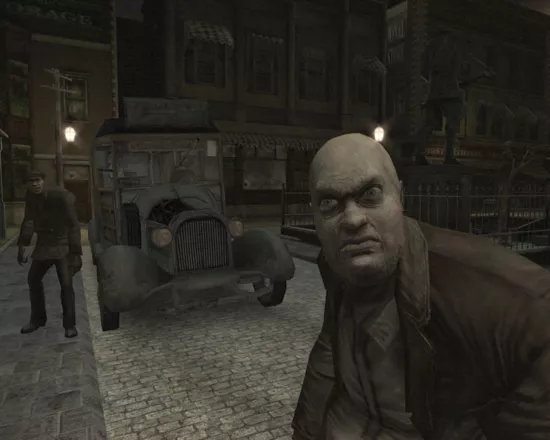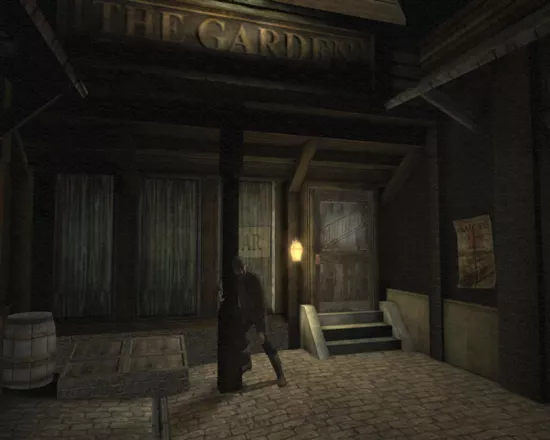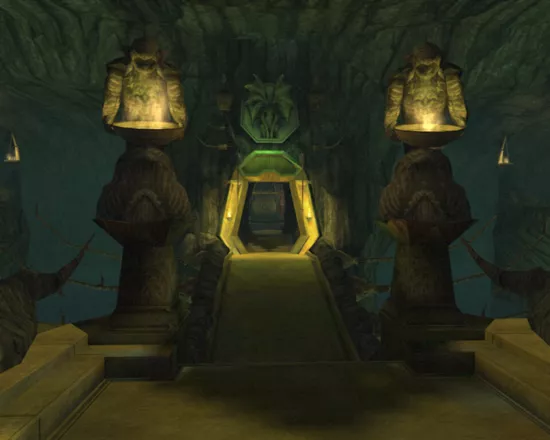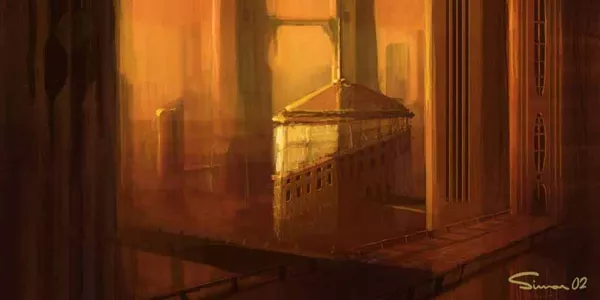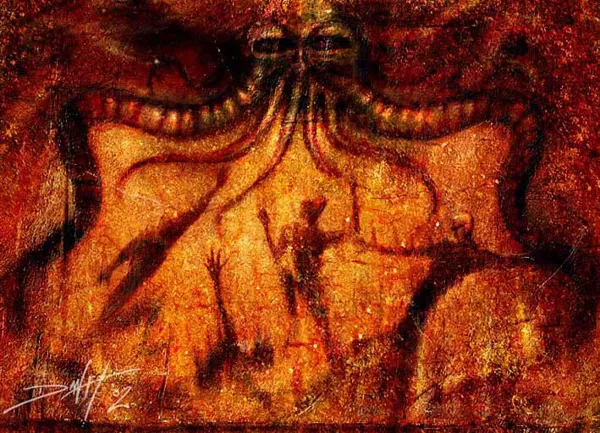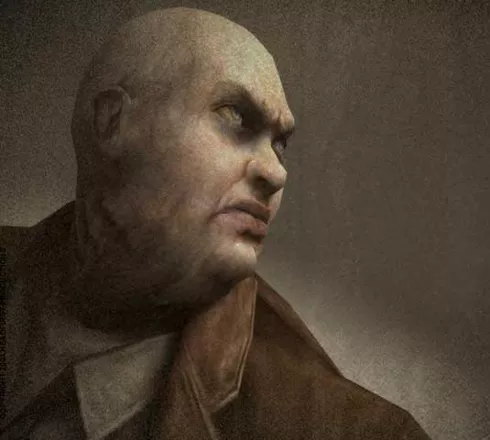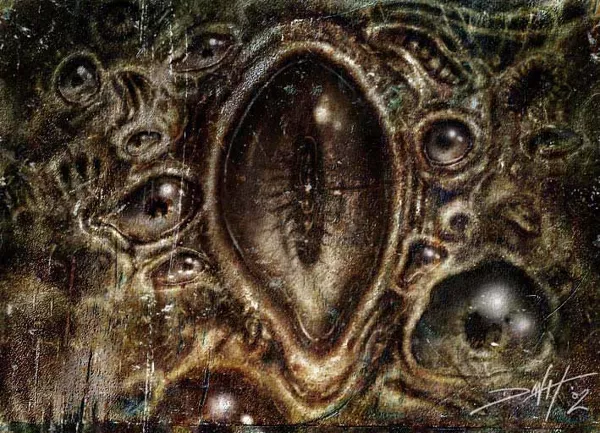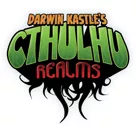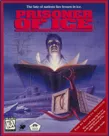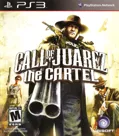Call of Cthulhu: Dark Corners of the Earth
Description official descriptions
Detective Jack Walters arrived in Innsmouth to solve a case of a missing person. But soon he finds himself confronted with terrible mysteries older than humanity, and with ghosts of the mysterious events that led to his incarceration in a mental hospital years ago.
Call of Cthulhu: Dark Corners of the Earth is a first-person action-adventure survival horror game, based on the H.P. Lovecraft mythos and his short story "The Shadow Over Innsmouth".
Initially, CoC: DCotE plays like an adventure game, but soon it gains elements of a stealth game and of a first-person shooter. Notably, the game does not feature an on-screen HUD (not even a crosshair); Jack's health is hinted at by visual cues; as for ammo, you need to remember how much you have left before you'll have to reload.
The health system used in the game is uncommon. There is no "hit points" system; rather, Jack receives minor or major wounds in specific parts of the body, and if he breaks a leg he's slowed down. To heal himself and prevent death from bleeding out, Jack can pick up medikits which contain bandages, splints, sutures and antidotes, each of which is used to heal a specific type of wound. Ill effects emerging from the wounds can be temporarily suppressed with a fix of morphine.
Jack's sanity also plays an important role. When Jack looks at disturbing things or finds himself in alarming conditions, his vision blurs, he begins hearing voices and talking to himself. If this gets too bad, Jack may go insane or commit suicide. Also, Jack suffers from acrophobia, and looking down in high places will cause him vertigo.
Spellings
- 邪神的呼唤:地球黑暗角落 - Chinese spelling (simplified)
Groups +
Screenshots
Promos
Credits (Xbox version)
94 People (91 developers, 3 thanks) · View all
| Producer | |
| Lead Designer | |
| Lead Engineer | |
| Lead Technical Artist | |
| Lead Creative Artist | |
| Lead Animator | |
| Senior Engineers | |
| Engineers | |
| Additional Design & Level Scripters | |
| Technical Art | |
| Background Art | |
| [ full credits ] | |
Reviews
Critics
Average score: 77% (based on 57 ratings)
Players
Average score: 3.8 out of 5 (based on 73 ratings with 7 reviews)
The Good
The story from start to finish is executed very well. There's a lot of stories to uncover and although it doesn't match Lovecraft's writing, for a computer game it's one of the better, if not the best.
The interface without any indicators also helps the game to be more realistic (injury is indicated by blurring of the screen, broken leg by limping, and so on).
Atmosphere is very dense and scary, escalated by creepy sounds and occasional but very fitting music.
For Czech language version - only texts and subtitles, but very expertly translated with perfect grammar and without lost of meaning.
The Bad
First of all, there's a big bug in some versions of the game (looking at forums it seems like a very common problem) - it is the place where you need to shoot with cannon at mages on the Devil's Reef. The problem is that you can't see them so you don't know where to shoot. There's three solutions to this: 1) Patch - The official patch is non-existent and fan-made unfortunately doesn't work for all versions (mine, for example), 2) Search through forums for saved game after this scene but you lose your Statistics, 3) set the sight on the exact coordinates - also can be found on internet (YouTube).
The movement and control is a little clumsy. There is no run, only walk, so don't count on escaping from any shootouts. The reloading of weapons is not very precise so sometimes you have to push the reload button at least twice. Auto-reload would be better solution I think.
There are different ending according to the Grade you receive (taking in account several Statistics), if you don't have a Grade good enough you will only see a shortened version of the outro. Not a good idea.
The Bottom Line
Call of Cthulhu can be described as an action adventure, or better - action game with adventure bits. You take the role of Jack Walters, a private detective who is hired by a store owner to investigate a case of missing employee of grocery store in Innsmouth (a village regarded as haunted by many). The story comes from a board game (which I'm not familiar) with. It's a mixture of several better known works of H.P. Lovecraft, most notably The Shadow over Innsmouth but also including events, creatures and references from short stories and novellas Call of Cthulhu, The Shadow Out of Time and At the Mountains of Madness. All of them recommeded read after finishing the game.
Not including the scary prelude of the game (I don't want to give out any spoilers), you start in Innsmouth, a dark town with unfriendly faces all around. You don't need to be a genius to know that they don't like strangers around there. Your first steps are to look for whereabouts of the missing person, but during your search, you'll made a great deal of horrifying revelations. The game changes from adventure, to stealth, to action very rapidly and there won't be many friends to help you. Eventually you pick up a variety of weapons to defend yourself and you have to decide which is better - to sneak by enemies, to fight them or to run away. New clues and events will be added into your diary but not until the very end you will be able to understand what's going on (and maybe not even after that, see column The Bad).
On inventory screen you will see everything you need - the items, ammunition, diary, medicaments and health. There's more than one type of injury - some lighter ones will heal itself eventually, some you must heal, broken bone must be fixed with split, poisoning must be treated with antidote. Injuries can be healed manually by picking the places to heal or automatically by clicking the button. Healing process itself takes a few seconds when you can't move so better hide yourself before you use it. You must also look after your psychical health, it means if you encounter too many scary events in quick succession, you start to feel dizzy, mumble to yourself and in the end commit suicide.
Looking at items and operating them is done by Use button. Using items in inventory on something is very easy, just by clicking at them, there is no combining of the items in inventory.
For the shooting there are two modes - quick shot and aimed shot, the latter being recommended as there is no crosshair to aim at. But don't aim too long or your hands begins to shake.
At last I recommend to play only at night because the game is VERY dark and the atmosphere and horror is greatly increased.
Overall Call of Cthulhu: Dark Corners of the Earth is an enjoyable game that is moderately long and can absorb you for a few weeks with a lot to think about during that time.
Windows · by Sun King (1555) · 2016
The Good
It happens with many games that there is a big difference between the initial project and the final result. The "Dark Corners" game is a very sad example of this. The difference is so huge that the vision and the final version of the game are going to be my "The Good" and "The Bad" of this review.
We go back in time many, many years from now. I don't remember the exact year, but I think it was probably 2001. The guys from Headfirst present the idea of making a game or a series of games based on the Cthulhu Mythos. It wasn't to be the first one based on the Mythos, but they had a lot of new ideas about how to design a horror game. The main idea was to simulate the hypothetical feelings of the character and transmit them to the player. In addition to these, there wasn't going to be any HUD (to add realism), and the damage on the character would affect him depending on the hit point.
To show all these ideas they made some concept videos that you can probably find in the web if you search a bit. Those videos were pretty revealing. We could watch the character losing his lamp into a pit when scared by the shadow of a monster, accelerating his breath after facing a corpse, having hallucinations where a companion transforms into some monster, etc. And there were more interesting ideas like having to look the barrel of your pistol to see how many bullets you have or cutting a bridge to stop your enemies or block a door with a chest and the feeling that everything was interactive. In addition to all this, there were more interesting and original ideas. I remember reading about the character suffering from vertigo, catching a cold when getting wet, limping when shot in a leg or having bad aim when shot in an arm and probably something more I'm forgetting.
They also add up to the expectation with promises like "you can solve problems in many ways", "you can play twice and it will be completely different", "everything you do will change the course of the story", and so on. They even wanted to make it cooperative, just imagine, a multiplayer not thought as a deathmatch, how many story-following coop multiplayers are out there?, two, three in the history of videogames? Considering that they wanted the game to be an investigation game too this all sounded very well. Obviously, many gamer looked closely to this game.
The Bad
Well, first of, remember never to buy a game before having played it. If you are still young or haven't played too many videogames you maybe still enjoy them, but with time you will learn that nowadays most of the games are the same and that everything that the marketing guys promise with each new game is a lie. Yes, I'm really pissed off with this game.
Now, about this game.
The story of the "actual horror" this game brings began even before its release date. The multiplayer option was discarded many years ago (too good to be true) and from then on everything went downhill. After some uncertainty on the project, the company obtained the money from Bethesda in May 03 and the project was definitely boosted. Of course, the release date was postponed many times, until they quit trying to do a good game and, finally, October 05 was the date. The game was nearly done by then for the XBox and for PC. But one or two weeks before the release day the PC version was delayed half a year (!!), and exactly the same happened with "Oblivion" (for XBox 360), another game from Bethesda. It's said that the CEO from Bethesda also made hamburgers with his dog for the guys of Microsoft that day.
But, finally (this is the last "finally", I swear), in April (I think) 06, the game was released for PC. Let's try to be schematic now because there is to much to say. The game is painfully linear, every original aspect of the gameplay is wrongly implemented and nearly everything in the game can make the experience annoying.
What they have done with the original ideas they had to improve realism and empathy with the character (Jack Walters) is probably the most disappointing thing. First of all, your character has no body. Remember games like "Project Eden", "F.E.A.R.", "Operation Flashpoint" and many others where, even having first person view, you could see your own body? Was that real! This is not a serious mistake, but it was disappointing for me. But the feature most of the people hate about the realism in this game is the fact that you can't run! They probably implement this to increase the sense of horror in the game, but is surely the most annoying feature of the game. You have 4 speeds: "walking" (slow), "crouching" (very slow), "sneaking" (desperately slow), "sneaking & crouching" ("somebody shoot me" slow). You will learn avoiding the last two very quickly, but the programmers seem to want you to suffer. You know, when some marketing guy says "you can confront problems in many ways", it means you can kill your enemies or sneak through them. Well, this game fulfills this fact with the addition that you wont have weapons in some parts of the game, which will force you to go move in this "de facto" slow-motion. At least, this game is really easy as a shooter, so, as soon as you get a weapon, you will need to sneak no more. Most of time, I have just stay there in front of my enemies aiming to their heads to kill them in one (or two) shot, is pretty easy. Yes, the game has more difficult modes, but you can't play them until you finish on the easier mode, and only a loony would play this game twice.
About the physical health system. You have a like a health menu, where you can see the body of your character with all the wounds he has at the moment, which look always the same and are always in the same place. In addition to this, you have a table with 6 parts of the body (there is only 6 hit points) and their state, and all the medical stuff you carry. There are 4 types of wounds, light, heavy, broken bone and poisoned and you have all you need to heal them in a medikit. The poison is something very rare, as there is only one kind of enemy that poisons you, and it appears twice in the whole game. There is a different object to heal each type of wound and in each medikit you find there is a different amount of each. You will always have antidote as you never use it for anything else, so the poison feature is pretty forgettable. When you get hit in the legs or fall, you walk (even) slower and you can't jump and if you are hit in an arm, I think your aim get worse, but I didn't notice it really. If you lose to much blood I think the screen went black and white and previously, after severely wounded, your breath go faster. It sounds fancy, but it is not, really. If you have no weapons and you are hit in a leg, you are as sure as dead, if you have weapons, the praxis is like this. You go around killing enemies, if you are hit, you stop moving, kill all the nearby enemies and heal. If you breath to fast (or was it your heartbeat?), there is some risk for you to die, but not too much. The different ways of healing can be replaced by the "healing button", and, as the first gets annoying very quickly, you'll use the healing button. So, it reduces fast to pushing a button, the fast breathing is nothing new and the limping is just a slow motion. And you don't get cold at all.
About the psychic health system. All the promises of a complex sanity system reduce to two: you can go insane, you suffer from vertigo. The first one goes like this. There are certain scenes that will scare you, most of them involving corpses or limbs, and the big bosses scare you, but you wont be scare by nothing else, no matter if you are surrounded by enemies or in a very bizarre place, it's only about corpses (and stuff) and big bosses. If you get too scared by something, the heartbeat accelerates and the screen waves, then you suffer a mental collapse and the game just ends. When the screen begins to wave, is usually impossible to get sane again. The silly thing is that only big bosses can make your mind to collapse, as the creepy scenes are only some seconds and they are usually programmed so you can avoid them, but, if you avoid the creepy scenes, what are you playing this game for? So, that's how you play this aspect of the game: you try to watch all the creepy things you can (it doesn't matter anyway) and when you go crazy fighting a big boss even when you weren't doing nothing different from other times, you just reload the game for the fifteenth time to save some time. And, instead of hallucinations Jack has "visions" from the very eyes of his enemies. These are programmed to happens as intros loaded at certain points of each level, in a completely deterministic way. When you pass through certain point of a map you watch a vision, always the same vision. It is suppose to give you advantage on your enemies or just help to the mood of mystery and horror. And yet, it gets annoying. It happens that these visions can't be skipped, so, when you get stuck at some point of the game (something frequent) and there is a vision in at this point, you are going to have to fully watch this vision every time you reload. The intros are skippable, but the visions, for some reason, not.
And the vertigo feature gets also annoying! It works like this. If your are 4+ meter high and look down near an edge, the screen goes blurry. It basically means that you can't jump from platform to platform looking down, and this is pretty difficult in FPS games. And it has nothing to do with your sanity status at all, the guy just has vertigo. It's not a big deal, but there are some levels in the first part of the game where there are very narrow platforms involved, which you will need to repeat many times. The vertigo feature is another feature that makes the game more annoying than fun.
You'll notice very soon too that the game is very linear. So linear that you'll have all the time that sensation that everything waits for you to happen. Even when you meet NPCs, there is only one conversation possible, even when the scenario is wide and with multiple paths you will have a strict script to follow, even when you can or have to go back nothing new will happen unless you have made what you have to. Seriously, sometimes when you don't do what you are suppose to do, the game reacts stupidly forcing you to load a previous game. There is a place, for example, where you have to follow a straight path and climb some creeper at the end. But, a couple of "big boss" kind of monster appear when you reach this plant. Well, if you try to run away up the creeper, the character falls and say "I can't get out until I kill them", no matter if your sanity is high or low or if anybody in the world would run the hell out of there, you just have to kill them. In fact, the bosses in this game are highly scripted forcing you to play each usually 20+ times until you find that concrete action you must perform to defeat them. For example, there is a big boss that block the path with a tentacle, which also uses to hit you. You can't pass through until you do certain thing. Well, if you try when the tentacle is hitting you, it just appears in front in a realistic speed, because you MUST follow the one and only script.
And if all of this were not enough, the game has a plague of bugs. Probably one of the main reasons is the mentioned linearity of the game, the script of the game is so closed shut, that every time the player does something unexpected (and the programmers have very little "expectations" on the player) the script can just fail and you need to reload a previous game. But there are of all kind. Remember the scene with the creeper from the previous paragraph?, well, after trying many times to kill these annoying monsters I found myself stuck there because the game "didn't know" that I had kill these two monsters. And there are also some intros that you can only hear because the video doesn't load correctly. And I want you to remember that this game was released half a year after the version for the XBox, and they have done nothing about the bugs! After laughing at us delaying the PC version unnecessarily. But the funniest thing with this game comes at the end. Yes, I'm going to spoil it, if you still are going to play this game (no, seriously), avoid this part.
It happens that the final level of this game is about Jack escaping form an underwater temple that is falling apart. Of course, there is only one path to follow, and yes, the character escapes walking!!, how silly is that? This is especially exasperating because there is a really random bug in this level: when you reach a tunnel nearly at the end of the level, suddenly, everything collapses and you die, just like that. The level is so easy that you could do it at the first time, but, instead, you have to repeat nearly the whole level for a random number of times (it took me 6 times, but it can be much more) and you must do it walking!! And the final video can be buggy, too!!, and you can only watch this video if you repeat all the level again to see if you have luck this time. But that means another random times the last level!! I didn't even finish the game technically nor watch the final video!!, I hate this game!, it's horrible!!
The Bottom Line
The collapse of the FPS games reaches its climax in this game. Everything that can be done wrong, and, especially, that can be done annoying, in a professional FPS is in this game: constant loads in too hard levels, an offensive linearity, too many scripting, uncreative levels, hundreds of boxes, exasperating bugs, sneaking oriented situations that nobody enjoys, very unrealistic movements and a character with no body, unchallenging shooting, adventure aspects that add very little to the game, etc. The promise of a new concept of horror game, where realistic behavior of the main character and the simulation of his feeling were an important part of the game, and the very common idea (that never prospers) of "every interaction with the world will make a difference" when projecting games, has become into a great failure.
Seriously, games are suppose to be fun, not to feel frustration all the time. And it's even more frustrating when you wait for a game for years and everything that has been promised is a big fat lie. Will they learn something for the next games in the series or will they just do the minimum to make some money? Learned lesson: Never give your love to a videogame project, :)
Windows · by MichaelPalin (1414) · 2006
A truly unique gaming experience... Which might or might not be a good thing.
The Good
In a true Lovecraftian style, DCotE opens right at the tragic ending of the story. As in 97% of the infamous author's work, the voiceover of the main character -in this case one Jack Walters; locked in a padded cell- rambles on about how whatever it is he experienced drove him nearly insane, and how lucky are all of us who don't even suspect about the horrors that are lurking at the bottom of the seas, inside our closets and under our beds, and how he would've killed himself long ago, were he not so afraid of the dreams that might come with that sleep of death.
Today, however, is the day Jack finally decides to take that difficult step --the one that kicks the chair back.
Game over, your character's dead.
Who ever thought that putting a chair and a rope in the cell of a delusional maniac depressive would be a good idea? Boy, someone's gonna hit the unemployment line before the day's over...
Kind of a short game, isn't it-- Oh, wait, we're rewinding.
OK. It's 6 years ago now --September 6, 1915 to be exact; which means the previous scene was about 90 years ago, review-on-website-wise. Jack Walters, who happens to be a respectable detective working with the police, arrives to a manor of sorts, where the members of some cult are having a healthy firefight with the law enforcement. The leader of the cult demands to speak with Jack, so our hero gets in the manor commando-style. Only he doesn't take a gun with him. Good call there, detective Gandhi.
Anyway, (some other) mistakes are made, the slippery slope, and eventually our man is handed his first taste of otherworldly horrors.
Fast forward and we're back 6 years into the future, minus 10 days. Tell me if all this time-travelling makes you sick, don't go puking on the seats, please. Jack is a freelance detective now, and apparently he's not been in his best shape for the last 6 years. We do know he'll be much worse within a week and a half, though, so I guess it's all relative.
While he's mumbling to himself about his fragmented memories of these 6 years, during which he happened to spend some time in a mental hospital (apparently he goes in there from time to time, then), he receives a call from some guy who wants his services. Our man doesn't like to be interrupted when he's pinning about his lost memories and his season at the madhouse with senseless crap like, you know, work and stuff; so it is with much reluctance that he ultimately reaches into the case files cabinet (A.K.A. the trash bin) and takes the envelope his client sent him God knows how long ago, with money and the stuff needed to kick off the case. Jack is to find the manager of a grocery store at the coastal town of Innsmouth, who's gone M.I.A. The local newspapers and authorities say the guy ran away with all the money, but his boss suspects something else is going on. Like, he probably didn't run away as much as he drove away in one of the company vehicles. Or maybe someone killed him and they're covering the whole deal. They're some pretty grim fellows down at Innsmouth, I can tell you.
This way, the adventure proper starts; the entire first stage being a free adaptation of the short story The Shadow Over Innsmouth. For the casual Lovecraft sympathizer (namely, me), it's a damned fine homage, from the very beginning with the travel as the sole passenger of the one bus that stops into town daily, to later that same night, when after a whole day of nosing around making tempers slowly flare, things go haywire and an unarmed Jack is chased through the rooftops and streets of the accursed town by the strange, xenophobic locals. I do know of hardcore Lovecraft fans that have quite a few complaints to make about the way the mythology's been treated, but hey, if you're a hardcore fan of this kind of literature, you can't be all that well up in the head, so who are you to talk.
Anyway, I recommend reading the story before playing the game (Come on, don't be such a lazy ass, it's about 50 pages long, man! And it's like 100 years old already, which means it's available for freely, 100% legal downloading everywhere.) to properly enjoy the joke.
This game has been in the making for no less than 7 years. During the process some stuff was added, some stuff was left out, promises were made that never even began to become a reality, people came in, people went out... The usual story. The one thing that's been a constant throughout the entire tortuous process was the promise of bringing the gamer a unique style of gameplay that would provide an extremely realistic experience. And this, they sure have achieved.
First things first, the technical aspects all hover around average-to-above levels. The graphics themselves look dated, with most of the characters' faces being rather inexpressive and the scenario textures being poor, small-sized and painfully given away especially when tiled --you can see the repeating patterns in any given street or wall too easily, which makes it look much less like a real street and much more like a dull wallpaper.
That said, characters are nicely animated, and they did pack in a bunch of special effects that more than make up for any criticism there could be made graphics-wise. For starters, they're using the most awesome jaggies-inhibiting effect I've ever seen; even if you set the game down at 640x480 with no antialiasing, you'll have to squint to see any jagged edges, and whatever it is they're doing, it has no major impact in the game's performance. It probably has to do with the dimly-lit, misty atmosphere present throughout the whole game, so it wouldn't probably work for, say, a
But graphics-wise, the main course is the protagonist's insanity: I'll get into detail further ahead, but for now let's say the visual effects are literally mind-bending, you'll truly feel the shocks the protagonist feels, the tension, the vertigo, and the almost palpable feeling of the sanity loss --reflections, refractions, motion blur; every little trick your video card can do to distort an image is put to work here.
The sound is split in half: On the one hand we have a soundtrack that -while not particularly memorable- does a perfect job to support the atmosphere (especially during the most stressful scenes) and believable sound effects, both the real ones (like the gunshots) and the unreal ones (like the monsters' grunting); and on the other hand we have the most painfully amateurish voice acting I've heard in years. We'll deal with that in time.
So, let's get into what makes this game so unique; which is, well, its uniqueness. The game is played from a first-person perspective, but it's FAR from your average shooter. Jack has to do a lot of sneaking, but it isn't a proper stealth game either; the game won't tell how visible or not Jack is, there are no noise level indicators, no cameras showing enemy positions... you're left to your own devices to judge which shadow is the darkest one, whether or not you're making too much noise, and so on, which is, well, just like it would be were you try to sneak on someone in the real world.
By the way, in the 100% pure stealth missions the AI is surprisingly good, and as long as you use your best real life discretion in order to sneak by, the enemies will perform greatly. Their field of view is expertly calculated, and you need to be very good at hiding to fool them. The mere fact that you're standing in the shadows doesn't make you invisible, Sam Fischer.
Anyway, we were saying there are no indicators. In fact, there's no "Heads Up Display" on screen at all, no superimposed text, nothing that stands between your character's eyes and your own. Every single thing presented on screen is strictly related to the story in motion, the way Jack sees it. Whenever you need to read the documents you pick up, manage your items, or check Jack's health status in detail (as well as heal his injuries) you go to a separated inventory screen while the action is paused. The HUD-less interface works so amazingly well it makes you wonder how come we ever got convinced that we needed to see a health bar or a bullet-count on screen at all times.
The management of the character's health is one of the things that stand out the most. Jack receives localized damage, which is not only visually represented in a schematic of his body in the inventory screen, but can also be felt during gameplay. Take a wound on your arm, and your aiming will be impaired, take a wound to the head and bloodstains will hamper your vision (This is, if you survive such wound --a head shot can be as deadly to you as it is to your enemies), take wounds to the legs and you'll feel Jack's pain as he limps and moans in pain.
The injuries you can take are of different types, and health kits provide different types of treatment for each one of them; which makes for some light strategizing, since you have to be careful with the management of your supplies, of which you can carry a limited number. For example, a heavy bleeding wound is quickly taken care of with sutures, but then these are way too scarce. You could choose to just wait until the injury turns to light bleeding and treat it with (widely available) bandages, but then you'd be walking around injuried until that happened, with the risk of being weaker and, depending on where the wound is located, having different abilities impaired.
Also, while healing an injury makes it disappear instantly in a very videogamey fashion, the healing process does take up to a few seconds depending on its complexity, so it can only be done once Jack is in a relatively calmed spot. In case of an emergency, the inventory also has morphine shots that give Jack a little speed boost and help numbing the pain, but then his vision will be blurred, with the obvious consequences to his aiming capability; not to mention that repeatedly abusing the drug might end up being fatal. You know, stay in school and all that.
During the first few stages of the game Jack goes around unarmed, a perfect victim to his enemies, his speed and wits at running from or sneaking by his captors his only chances for survival (Again, Innsmouth's chase has to be one of the best parts of the game, if no THE best part, even with all the frustration it can bring.); but then he eventually gets a hold of a weapon (and 3 or 4 more later on)... which doesn't exactly make things that much easier.
Like I said before, this game is not a shooter. Our man is simply too clumsy to ever make it into Quake's cast, but the odd thing is, his awkwardness at handling weapons doesn't feel like the product of a faulty game engine, but rather the carefully planned effect of a very capable one. Like it's supposed to be this way. Unlike every other game where you handle weapons, in DCotE you actually get the feeling of the thing having weight, like you would probably feel when using a real weapon. There's no crosshair on screen, so you can either take your chances with a blind shot from the default position or use the "aim" button, which puts the weapon right in front of your eyes, so you aim with the weapon's own sights, as it's supposed to be done. It's harder than it sounds, but it's also quite rewarding once you get the trick, it's like you're actually learning how to shoot properly.
It's a good thing Jack Thompson probably won't ever hear of this game, or you can already imagine the lawsuits that phrase alone could spawn...
By now you're probably wondering whether so much reality in a videogame won't end up being a bad thing, like, won't such a complicated healing system turn firefights into an infuriating experience?
Well, here's the thing. It does get annoying a lot of times. In fact, to be honest, there are quite a few spots where it gets videogameishly annoying (more on this in a minute); but for the most part, the whole system works. I was annoyed several times, but I couldn't help but admitting that it would've been just how things actually would have played out in reality, so it was only fair. Like it isn't the developers' fault, but rather reality's fault for it not being more like a regular videogame.
For example, I'm walking on a thin wooden beam, a couple stories high. Below me, several rabid folks are on the lookout, so at all times I'm risking being spotted and promptly shot down. In a very videogamey fashion, I look down to monitor their behavior, and whoOooOOOoa!, the whole world starts spinning around me!! So walking forward suddenly becomes a pain in the neck for some seconds, as it turns really hard to tell what's forward and what's what.
I could choose to make the whole walk looking up to avoid the vertigo, but I wouldn't see where I'm stepping, with predictable results. So, the secret is to try and walk calmly, staring straight ahead at all times, not looking down no matter what happens, and pray that noone below thinks about looking up.
In a regular videogame, you wouldn't ever expect having to be so careful in such a situation, but doesn't it sound just like you would act in real life?
There are dozens of small details that enhance the immersion, like when every time you use an item or interact with the scenery, you actually see Jack's hands at work (In fact, his hands were supposed to show up even when you opened a door or picked up an item, but that was left out as it came out quite buggy); but hands down, the most outstanding feature of the game is the aforementioned sanity system.
We know Jack Walters is a regular at the local mental hospital, and he's about to be confronted face to face with stuff that's supposed to be buried deep beneath the oceans for ever, so his sanity is at stake at all times. The more he comes in contact with disturbing imagery, be it a human corpse or a Lovecraftian monster, his pulse will accelerate and his perception of the world will be distorted in one of many possible ways. For every time the game makes you jump off your seat with a scary image or sound, you get to see Jack suffering the same experience, tenfold. Sometimes he'll even need to take cover in a safe spot to catch his breath and wait for the scenery to stop dancing around in a nausea-inducing fashion. It's the first time, as far as I know, that a horror videogame character reacts to the situation he's living like a real human being would.
The more exposed to disturbing imagery Jack is, the closer to a massive sanity failure, which means game over.
Keeping Jack sane is kind of tricky, especially since certain character dies because of him, and from that point on he's permanently haunted by ghostly visions fed by his own guilt, and they can show up anywhere. These visions -as almost every disturbing events, actually- can be avoided in order to minimize the overall sanity loss, but the scary scenes are the exact same reason why we play horror games, so sanity be damned, I went to get as many as I could. Poor Jack.
In this regard, there's a huge amount of delicious scary moments. Sometimes they're your typical "Boo!" device, placed in plain sight, like when you open a door and get a shockingly effective shot at the half-decomposed corpse of a hanging woman; but the truly memorable ones are more subtly placed, and they're sort of a sadistic reward to your curiosity --you can actually miss many of them if you just rush through the levels.
At a given point, I was walking down the street and passed by a house with street-level basement windows. I crouched to peek inside, and the exact moment I did it, I just managed to see a door slamming shut. It was as simple as it was great. The incredibly precise timing they got there is commendable.
Often during the game, the perspective will switch for a couple of seconds from Jack's eyes to something else's eyes, something that comes rushing through halls, leaping from rooftop to rooftop, and even crawling on walls and ceilings, always seemingly just seconds away from Jack. So, I was walking up this flight of stairs and I saw a window. Suddenly, I switched to the eyes of something that came leaping on the rooftops, and I noticed it was (which is to say, I was) watching into the very window at the end of the stairs that I (Jack) was about to reach! So when I regain control of Jack, I rush upstairs, I turn to the window, and I manage to get a glimpse of... something. It was definitely there, but it managed to jump out of my sight too fast, before I could tell what the hell it was. It was amazing. I've read descriptions of such carefully timed almost-close-encounters in horror stories and such, but I can't remember having seen them this well crafted. Certainly not in videogames.
The Bad
WOW!! With all that, this has to be, like, the best game ever! Right?
Well, not quite.
First, as I said, the graphics look definitely dated. While all the technical tricks I've mentioned do make up for them to a certain extent, and what we do have is enough to craft an effective horror atmosphere, some things are just wrong; like the fact the textures seem to use only 16-bit color. You might not tell for the most part, but if you look at the sky in outdoors Innsmouth, you can't help but noticing something's definitely not right up there. It's ugly, and there's no way around it.
Then we have the sound. More specifically, the voice acting. It's terrible. Actually, it's beyond terrible. "Terrible" could be applied to
Jack Walters is kind of average, which is not exactly a good thing for a guy we'll be hearing throughout the entire game, but hey, it could've been worse. Then we start the game and we approach the manor with the cultists, and we meet the first few NPCs --OH DEAR GOD!!! --OK, that guy is pressing his nose between his index finger and thumb while reading his lines.
How could this slip into the final game? I haven't made even 5 minutes into the game, this is the part where you present your product! People might uninstall the whole thing just because of the massive hit to the game's overall impression that such an awful acting means.
If you really couldn't escape from having to cast the producer's talentless nephew, at least push him back into some obscure, worthless character in the second half of the game, but don't make him the very first person the protagonist speaks to!
The voice cast seems to be comprised of some 4 people, for no less than 8 relevant characters, and dozens of extras. So, like the one above, you have an endless line of failed attempts at faking voices. It's the most painful cast I had to endure in recent memory.
There's a particular "Don't let him get away!" voice track that every third bad guy would play, that made my skin crawl in horror; not because it sounded particularly threatening, mind you, but because it made me ponder on the fact that someone actually got paid money for such a lame-ass line delivery. I mean, most of the cast of the
Well, it does sound like it was.
Next, he have plot-related screw ups. One of the worst ones is Jack's personality, or rather, lack there of: He's constantly changing, it's really hard for anyone to identify with him. Usually he's this self-centered, reasonably smart guy, but every now and then he becomes a snotty prick you would smack right in the middle of the nose, and the change often happens right in the middle of a conversation, just like that.
There's a point at which he's looking for this woman, and he breaks in a house and, what do you know, he finds a woman who looks quite scared, and seems to be hiding. So, does he take the cue and realize here's his girl and tries to calm her down? --Nah, why would he? Let's better get all cocky and yell at her about how she's breaking into private property (excuse me?) and be the prick of the year to one of the three people in the entire town that doesn't seem to be ready to stab him in the back the moment he turns around.
His soulless, artificial voice acting doesn't make things any better, going to the extent of completely ruining a couple of otherwise intense scenes.
The storytelling is plagued by inconsistencies and plain stupidities that, while not terribly bad on their own, tend to undermine the big picture little by little. Like the names they gave to the levels/chapters; whoever it was that suggested the impossibly lame "Attack of the Fishmen", should've been fired at once.
Then again, it probably was that damned producer's nephew again. Damn his guts.
While it is true that some really picky Lovecraft fans complained about things that noone else would possibly notice, mythos-wise there are some details of the plot that can't be forgiven. One of the bigger ones being that, halfway into the game, you kill Dagon.
YOU. KILL. DAGON.
In case you're not familiar with the name, Dagon's one of the Old Ones, the unholy creatures around whom the entire Lovecraft mythology turn. Their groupies and hanger-ons like to refer to them with chants like: "That is not dead which eternally lies. After strange aeons hence, even death may die". That's a pretty daring motto to have, for a creature that takes 5 hits in the face to kill. Sure, those are torpedo hits, but still, the U.S. Army spent way more firepower in Bin Laden, and they never even found the guy.
All that said, however, the really important thing to criticize is the gameplay. While it is quite original and enjoyable once you get comfortable with it, and it's the very thing that makes the entire game stand out, it's also plagued by problems for which there's no excuse.
Jack can't run. He can walk, walk even slower while sneaking, and crawl while crouching. And that's it. That wouldn't be that much of an issue, if it wasn't for a few stages in which there's no other choice than to get away from some massive threat --the kind of threat you wouldn't leisurely stroll from, as much as you would sprint the hell away from.
In fact, there's been complaints in the official forums about the last stage of the game, where Jack escapes from a crumbling building, since a lot of people are getting stuck, unable to complete the final portion of the game because Jack's default speed prevents them from beating the stage's timer. And it is known to be a a problem with the speed, because you can alter the walking speed by hacking into the main .exe file, and any value above the default one solves the problem automagically.
Oddly enough, a little fiddling into said file reveals a variable called RunningSpeed, which defaults to a noticeably higher value than WalkingSpeed. Yet, as I've just said, there's no "run" key in the game. What the hell's that about?
The AI, while great in the stealth missions, is terrible in combat. Enemies rarely go for cover, they won't take any advantage of their numerical superiority, an they'll always fall for the most silly and obvious forms of ambush you can pull out. Many times you can actually bump into an enemy and he'll simply stand still with a blank expression and maybe fire a shot every two seconds while you fill him full of lead.
If you followed the game hype during the early years, you might remember Andrew Brazier speaking about the physics engine: «Our advanced real-time physics will be an essential part of the gameplay and atmosphere creation. [...] In terms of gameplay, this has far-reaching implications as it means there will be a number of ways to solve any particular puzzle.» That was January 2000, and that did sound like a promising feature back then. Today, 6 years later, the version 3.0 of the stunning Havok physics engine is out there, which made things look even more promising since, in the worst possible case, the DCotE team could still go an license it. There was no way they could not fulfill their promise.
However, neither the physics engine nor any of that gameplay goodness it was supposed to bring are anywhere to be found in the final game.
First, not only interaction with the world is hovering dangerously near zero, but whatever gimmicky physics-related problem-solving device there is, gets used only in the particular stage it is introduced, and never again. Once you learned using a given ability, your only chance at leveraging your experience in it, is a second playthrough. After that particular level is done with, you can just as well forget what you learned, for all it matters.
For example, while being chased in the hotel down at Innsmouth, Jack can (he actually has to) push furniture around to block doors behind him, thus slowing down his foes. However, that's the only stage in which he's gonna do that. He can't push a single thing during the rest of the game, just like that. Go realism.
On the other hand, along with the physics engine, gone are the promised multiple ways to solve problems. And, to quote my friend Andrew up there, this has far-reaching implications. You see, DCotE plays a little like a shooter and a little like a stealth game, but the overall feeling is that of an adventure game, where you need to figure the right way to beat each challenge. And this is a very bad thing.
You can find alternate ways to solve a given situation, but whenever you stray from the predefined path it becomes painfully obvious. You might succeed (though chances are you won't), but you get the feeling that you're not doing things the proper way, you either missed or screwed up something, and ended up having to do things this other way, which simply doesn't feel right. Rather than taking an alternate path, it feels like you're exploiting a design flaw.
Thus, much in the same way adventure games are meant for smart people, but only if they are smart in the exact way the developers were smart when planning the puzzles, DCotE is realistic, but only for the exact reality the developers had in mind when designing it. A game with so much emphasis on its realism should have had a much more open-ended gameplay. It was mandatory. Having to solve the game on rails as it is, sends all the realism down the drain.
Adding insult to injury, you can't quicksave. I did speak against the overuse of quicksave in the past, and I stand by that, but some games just beg for this feature.
DCotE not only plays like an adventure where you have to solve problems in the exact way the developers meant it, it plays like a really awful adventure where most solutions can only be found by trial an error. In an adventure game, this would translate into a dull exercise in pixel-hunting or use-everything-with-everything. In a game with this much action, it translates in repeatedly dying until you figure out the way to go.
Needless to say, if this happens 10 minutes away from the nearest savepoint, it gets downright infuriating.
One final annoyance has to be the fact that, despite all the realism these people have going on here, us players couldn't escape from having to endure, once again, a number of bad cliches, including but not limited to -ready those rotten tomatoes, people- jumping puzzles.
Can it be possible?
Dear game developers: JUMPING PUZZLES DON'T WORK IN FIRST PERSON PERSPECTIVE GAMES. WE ALL HATE IT WHEN YOU DO THIS, WE'VE SAID IT ABOUT A GAZILLION TIMES IN THE LAST 7 YEARS, AND IN FACT YOU NEVER EVEN SHOULD'VE NEEDED TO BE TOLD SO IN THE FIRST PLACE!! IT'S F'ING COMMON SENSE, GODDAMNIT!!!!
And when a game that revels in its uniqueness pulls them out, it's twice as bad.
The Bottom Line
So, what do we do with this one?
To be quite honest, I'm still no sure whether I love or I hate this game.
DCotE is one of the most vividly realistic experiences to ever exist in the form of a videogame. Applied to a horror game, this translates in a recipe for awesome, in any language. Some other games might or might not do a better job to make you jump off your seat with their "Boo!" techniques, but I don't think there's a game that captures and transmits the true feeling of tension, shock, vertigo, pure, genuine fear, and the dreadful sense of being slowly descending into madness like this one. You do feel every little thing your character experiences as if it was happening to you, and your character does experience the things he's put through, unlike most horror games' protagonists that simply see them pass by.
The game features plenty of sneaking and shooting, both things we've done countless times in the past, but it manages to do them in an oddly realistic way that makes them feel like a total novelty. This amounts to equally high levels of enjoyment and frustration, so make what you will of that.
On the other hand, the game can get impossibly annoying at times because of a number of bad decisions, bad storytelling and acting, inopportune resorting to awful videogame cliches, and -worst of all- the most painful form of linearity, in which not only you can't stray from the path intended to solve each situation, but you actually have to randomly guess what the developers had in mind in each case, which is usually much harder than it sounds, since while at it you can get killed too many times, being forced to replay some stages until you learn to honestly hate them.
All that said, the first thing I did once I finished the game was starting over again.
That was about a week ago and, even though it still gets annoying at times, I'm enjoying it like a degenerate maniac. Maybe even more so than the first time through.
Windows · by Slug Camargo (583) · 2006
Trivia
Details
When playing Call of Cthulhu: Dark Corners of the Earth pay close attention to your surroundings, especially during the first hour or so of playing. Look on rooftops, peek through the occasional cellar window and so on. There are a lot of little "details" in the environments and you might catch a glimpse of something you didn't expect, and it might even be a bit disturbing. These can range from quick glimpses of some inhuman horror as it passes by a window to seeing a dead body that's been hanging from the ceiling for weeks.
Development
The March 27, 2006 release date of the PC version ended a six-year cycle of development hell. Headfirst began developing Dark Corners of the Earth for a German publisher named Fishtank. Fishtank was taken over by JoWood and JoWood wasn't interested in the title. Headfirst continued development while searching for publishers. Bethesda ended up with the publishing rights, but they wanted it as an Xbox title, not a PC game.
The Xbox version was released in October of 2005. Shortly after that, Headfirst entered into financial difficulties which affected their ability to pay their employees, leaving many of them to find employment elsewhere. Headfirst was forced to sell their Simon the Sorcerer license to Silver Style and put their offices up for sale. The remaining Headfirst employees completed the port of Dark Corners of the Earth. As of 2006, plans for additional Call of Cthulhu games, Destiny's End and Beyond the Mountains of Madness seem to be dead.
German version
The Xbox version (when having the console set to German) misses all blood effects when hurting enemies. All other blood effects are untouched.
References
Take a look at the posters of Brian Burnham, which are scattered through the game, on these he has a striking resemblance to H.P. Lovecraft.
Usenet
The development of Dark Corners of the Earth can be traced back to a 1999 Usenet post where Headfirst's Andrew Brazier asked alt.horror.cthulhu readers, "What would you want to see in a Cthulh (sic) computer game ?"
Awards
- GameSpy
- 2006 – Level of the Year (PC) (for Hotel Escape)
Information also contributed by MasterMegid and Robstein
Analytics
Upgrade to MobyPro to view research rankings!
Related Sites +
-
Official Site
Official Site for Call of Cthulhu: Dark Corners of the Earth
Identifiers +
Contribute
Are you familiar with this game? Help document and preserve this entry in video game history! If your contribution is approved, you will earn points and be credited as a contributor.
Contributors to this Entry
Game added by Dwango.
Windows added by Kabushi.
Additional contributors: Terrence Bosky, Unicorn Lynx, n][rvana, Alaka, UV, Eltahriel, Patrick Bregger.
Game added January 23, 2006. Last modified March 15, 2024.
